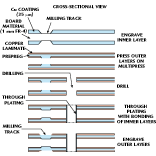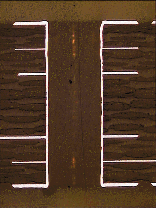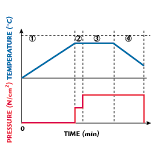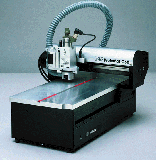CDMA RFIC Upconverters
QUALCOMM Inc.
San Diego, CA
Few products are on a faster track than today’s digital wireless handsets. Currently, the industry is scrambling to meet the demand for these improved telephones. As a result, component manufacturers must generate new devices that enable the handset manufacturers to design this new equipment to meet sophisticated performance criteria in a rapid and reliable fashion.
The types U1000 wideband and U1100 dual-band upconverters are part of a growing family of code-division multiple access (CDMA) RFIC components designed specifically for the transmit sections of both dual-mode CDMA/FM cellular and personal communications service (PCS) handset applications. The ICs also are suitable for use in other digital cellular systems, such as time-division multiple access (TDMA) and Global System for Mobile communications (GSM).
Upconverter Descriptions
 The upconverters have been designed to operate from low (2.70 to 3.78 V DC) supply voltages and require low (–6 dBm) LO input power. All input and output impedance matching is accomplished on chip and good noise performance is achieved. The new low cost devices are supplied in an eight-lead SOIC plastic package. Figure 1 shows the devices’ pinout diagrams.
The upconverters have been designed to operate from low (2.70 to 3.78 V DC) supply voltages and require low (–6 dBm) LO input power. All input and output impedance matching is accomplished on chip and good noise performance is achieved. The new low cost devices are supplied in an eight-lead SOIC plastic package. Figure 1 shows the devices’ pinout diagrams.
The RF performance of these devices has been characterized specifically over the 824 to 1910 MHz frequency band. In addition, the type U1100 dual-band upconverter includes two selectable RF outputs to accommodate dual-band/dual-mode CDMA telephone applications for operation between the PCS and cellular FM bands.
Both devices utilize a nominal 130.38 MHz IF and feature typical conversion gains of 0.6 +/-0.3 dB for the cellular frequency band and –0.4 +/-0.2 dB for the PCS band. The upconverter ICs’ excellent ACPR, shown in Figure 2 , is important for proper spread spectrum system operation. Typical noise figures are 11 and 12 dB for the U1000 and U1100 devices, respectively. Both units draw approximately 24 mA and operate over a –30° to +80°C case temperature range.
gains of 0.6 +/-0.3 dB for the cellular frequency band and –0.4 +/-0.2 dB for the PCS band. The upconverter ICs’ excellent ACPR, shown in Figure 2 , is important for proper spread spectrum system operation. Typical noise figures are 11 and 12 dB for the U1000 and U1100 devices, respectively. Both units draw approximately 24 mA and operate over a –30° to +80°C case temperature range.
The upconverters feature a differential IF input (internally matched to a nominal 265 W impedance) that reduces the effects of common-mode noise and allows a direct connection to differential IF automatic gain control (AGC) amplifiers or bandpass filters. The ICs also include input and output impedance matching on chip.
Evaluation Boards
 Two evaluation boards have been designed to aid in testing and evaluating the RFIC upconverters. The model U1000-EB evaluation board is designed for evaluating the type U1000 wideband upconverter by placing the IC in a test circuit that provides proper interfacing and impedance matching over the unit’s operating bandwidth. The model U1100-EB evaluation board demonstrates the performance of the type U1100 dual-band upconverter in a similar test circuit. Figure 3 shows the two evaluation boards.
Two evaluation boards have been designed to aid in testing and evaluating the RFIC upconverters. The model U1000-EB evaluation board is designed for evaluating the type U1000 wideband upconverter by placing the IC in a test circuit that provides proper interfacing and impedance matching over the unit’s operating bandwidth. The model U1100-EB evaluation board demonstrates the performance of the type U1100 dual-band upconverter in a similar test circuit. Figure 3 shows the two evaluation boards.
Applications
Figure 4 shows an example of a typical dual-mode CDMA/Advanced Mobile Phone System (AMPS) cellular telephone. In addition to the U1000 upconverter RFIC, the block diagram contains the MSM3000 mobile station modem IC and transmit and receive IF converters (part numbers IFT3000 and IFR3000, respectively). These additional devices perform all of the signal processing in the subscriber unit, from IF to audio. The MSM3000 IC integrates functions that support a dual-mode CDMA/FM subscriber unit and contains a CDMA processor, digital FM processor, digital signal processor for voice compression, microprocessor and several other support functions. The mobile station modem demodulates receive digital baseband data from the receive IF converter.
Phone System (AMPS) cellular telephone. In addition to the U1000 upconverter RFIC, the block diagram contains the MSM3000 mobile station modem IC and transmit and receive IF converters (part numbers IFT3000 and IFR3000, respectively). These additional devices perform all of the signal processing in the subscriber unit, from IF to audio. The MSM3000 IC integrates functions that support a dual-mode CDMA/FM subscriber unit and contains a CDMA processor, digital FM processor, digital signal processor for voice compression, microprocessor and several other support functions. The mobile station modem demodulates receive digital baseband data from the receive IF converter.
The IFR3000 IC converts the modulated IF signal from the RF section into digital baseband data. The receive IF converter contains the receive AGC amplifier, IF mixer, CDMA/FM lowpass filters, analog-to-digital converters, clock generators that drive the telephone’s digital processor and a VCO that provides the receive mixer LO signal.
On the transmit side, the mobile station modem modulates and sends digital baseband data to the IFT3000 IC, which in turn converts transmit digital baseband data into modulated IF. The IFT3000 IC contains digital-to-analog converters, lowpass filters, a mixer for upconverting to IF and an AGC amplifier. Also included in the transmit IF IC is a fully programmable phase-locked loop for generating the transmit LO for the first upconversion. All told, the four described ICs provide a major portion of the subscriber unit’s circuitry.
In addition to the CDMA applications outlined, the U1000 wideband and U1100 dual-band upconverters are suitable for use in wireless local loop, TDMA and GSM/digital communications systems, and other spread spectrum telephone applications. Samples of the U1000 and U1100 RFICs and their associated evaluation boards are available currently. Full production quantities will be available in the third quarter of the year. Additional information can be obtained from the company’s Web site at http://www.qualcomm.com.
QUALCOMM Inc.,
San Diego, CA
(619) 587-1121.
